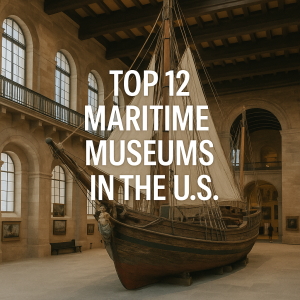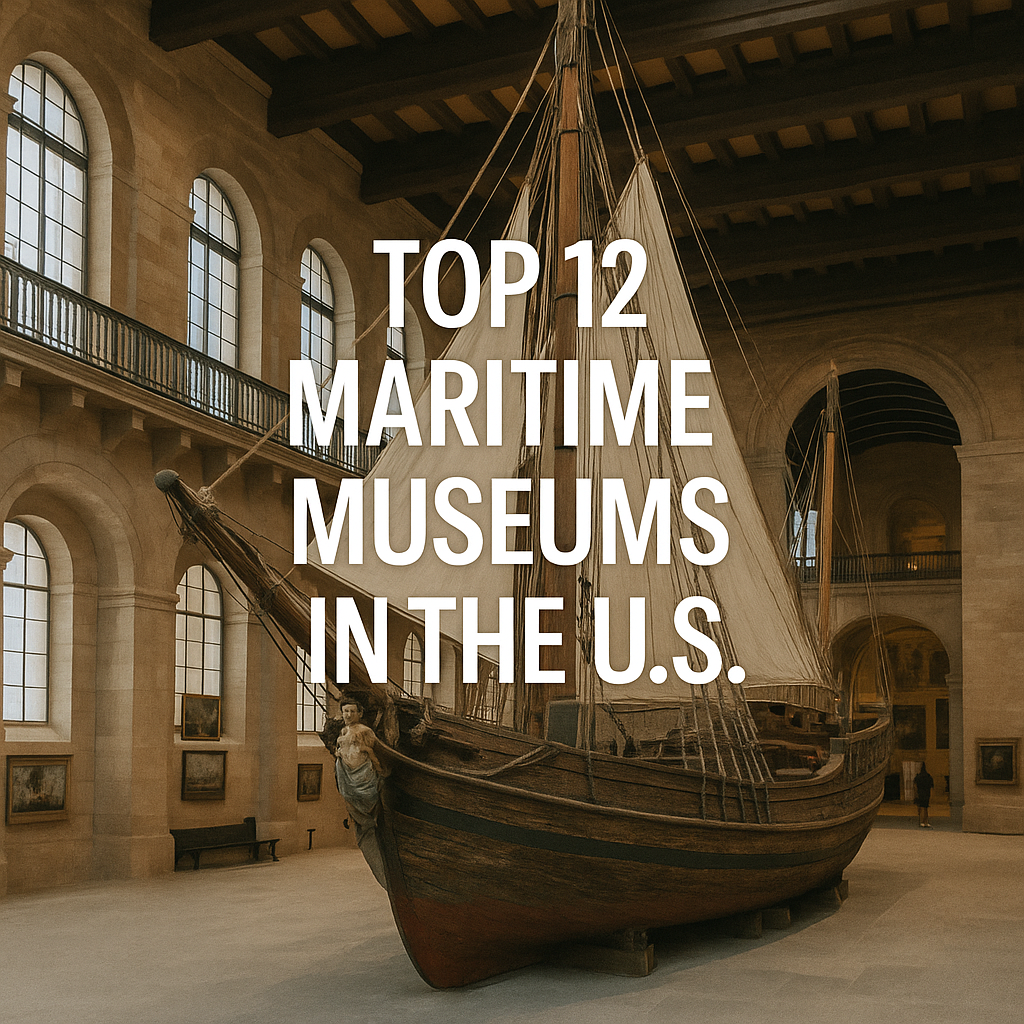Explore the top 12 maritime museums in the U.S. that preserve naval history, innovation, and seafaring culture. Discover how these institutions enrich maritime education and professional knowledge.

Why Maritime Museums Matter in Modern Maritime Operations
Maritime museums are not just storehouses of ancient ship models and faded nautical charts. They are dynamic centers for education, preservation, and innovation. In an era where the global maritime industry is rapidly evolving—thanks to decarbonization, digitalization, and climate change adaptation—understanding the history of seafaring becomes more crucial than ever. These museums connect the dots between past navigation techniques and today’s smart shipping systems. They also play an essential role in maritime training and public engagement.
According to the International Maritime Organization (IMO), maritime heritage promotes a sense of continuity in an industry often seen through the lens of future technology. Whether you’re a cadet, an experienced mariner, or a curious tourist, the following U.S.-based maritime museums offer unique perspectives and unforgettable insights.
1. The Mariners’ Museum and Park (Newport News, Virginia)
One of the largest maritime museums in North America, The Mariners’ Museum is home to over 35,000 artifacts including the USS Monitor Center. It serves as a national hub for Civil War naval history and cutting-edge underwater archaeology. This museum also collaborates with NOAA and the Naval History and Heritage Command, reinforcing its status as a vital educational platform.
Highlight: Life-size replica of the USS Monitor turret and immersive 3D experiences.
Website: marinersmuseum.org
2. Mystic Seaport Museum (Mystic, Connecticut)
The largest maritime museum in the U.S., Mystic Seaport is more than a museum—it’s a working seaport. Visitors can explore the historic tall ship Charles W. Morgan, a whaling vessel from 1841, restored using traditional shipbuilding techniques. The museum is actively involved in sustainability discussions around marine biodiversity, aligning with NOAA and the National Fish and Wildlife Foundation (NFWF).
Highlight: Functioning shipyard and maritime planetarium.
Website: mysticseaport.org
3. USS Midway Museum (San Diego, California)
Housed aboard the decommissioned aircraft carrier USS Midway, this museum offers interactive exhibits on naval aviation and the Cold War era. It’s also a case study in converting military vessels into educational experiences, reflecting strategies discussed by the U.S. Coast Guard and Naval Sea Systems Command.
Highlight: Flight simulators and guided tours by retired naval officers.
Website: midway.org
4. San Francisco Maritime National Historical Park (California)
This maritime park includes a fleet of historic ships like the Balclutha, a late 19th-century square-rigged ship. It’s managed by the National Park Service and frequently collaborates with institutions like the Smithsonian and NOAA on conservation efforts.
Highlight: Interactive exhibits on the Gold Rush and Pacific shipping.
Website: nps.gov/safr
5. South Street Seaport Museum (New York City, New York)
Once the heart of American commerce, this historic port district is now an open-air maritime classroom. The museum focuses on port city economics and global trade, frequently referencing UNCTAD and the World Bank in its exhibitions.
Highlight: Wavertree, a restored cargo ship from 1885.
Website: southstreetseaportmuseum.org
6. Great Lakes Science Center & Steamship William G. Mather (Cleveland, Ohio)
Home to the bulk freighter William G. Mather, this museum offers insights into the Great Lakes’ critical role in the U.S. shipping industry. It’s aligned with research from the American Bureau of Shipping (ABS) on inland waterway logistics and sustainability.
Highlight: STEM-focused exhibits linking maritime and industrial innovation.
Website: greatscience.com
7. Texas Seaport Museum (Galveston, Texas)
Known for the historic tall ship Elissa, the Texas Seaport Museum presents Gulf of Mexico maritime history. It’s also involved in hurricane resilience studies and coastal shipping discussions supported by FEMA and NOAA.
Highlight: Elissa, one of the oldest ships still sailing today.
Website: galvestonhistory.org
8. Independence Seaport Museum (Philadelphia, Pennsylvania)
Located along the Delaware River, this museum explores U.S. naval innovation through ships like the USS Olympia. It regularly hosts educational programs tied to maritime STEM careers and environmental science.
Highlight: Hands-on exhibits and boatbuilding workshops.
Website: phillyseaport.org
9. Columbia River Maritime Museum (Astoria, Oregon)
This museum documents the treacherous Columbia River Bar and the brave pilots who navigate it. Partnering with the U.S. Coast Guard, it offers simulations and real-time data from MarineTraffic and AIS tracking.
Highlight: Virtual bar crossing experience.
Website: crmm.org
10. Maine Maritime Museum (Bath, Maine)
Located near the historic Bath Iron Works shipyard, this museum bridges past and present naval construction. It explores the evolution from wooden schooners to modern warships and engages with RINA and ClassNK for technical accuracy.
Highlight: Historic shipyard and blacksmith demonstrations.
Website: mainemaritimemuseum.org
11. Lake Champlain Maritime Museum (Vergennes, Vermont)
A leader in freshwater maritime archaeology, this museum explores shipwrecks and underwater discoveries in Lake Champlain. It aligns with programs by the National Geographic Society and U.S. Geological Survey.
Highlight: Submerged shipwrecks explored via ROV.
Website: lcmm.org
12. North Carolina Maritime Museum (Beaufort, North Carolina)
Famous for its collection from Blackbeard’s flagship Queen Anne’s Revenge, this museum combines maritime history with marine biology and coastal ecology. It’s part of the state’s network of environmental education centers.
Highlight: Pirate history meets ocean conservation.
Website: ncmaritimemuseums.com
–
Case Study: USS Monitor Center – Where Engineering Meets Heritage
The USS Monitor, the Union Navy’s first ironclad, revolutionized naval architecture. Today, its preservation at The Mariners’ Museum is a textbook example of cross-agency collaboration. With NOAA and the U.S. Navy, the museum manages the recovery and conservation of artifacts from the wreck site. This initiative contributes to maritime education and corrosion management strategies used by Class societies like DNV and ABS.
FAQs
1. Are maritime museums only for history buffs?
No. Many museums today offer hands-on exhibits, STEM programs, and maritime career guidance for professionals and students alike.
2. Do these museums contribute to maritime research?
Yes. Many collaborate with NOAA, IMO, and class societies for exhibitions, preservation, and educational outreach.
3. Can I see real ships at these museums?
Absolutely. From aircraft carriers like the USS Midway to whaling ships like Charles W. Morgan, many museums feature full-scale, boardable vessels.
4. Are these museums accessible to schools and maritime academies?
Yes, most provide special group tours, educator resources, and virtual field trips aligned with national education standards.
5. How are museums adapting to climate change topics?
Institutions like the Columbia River and Maine Maritime Museums now include exhibits on climate impact, decarbonization, and ocean health.
6. Do these museums have online resources?
Many offer digital archives, virtual tours, and e-learning modules, useful for remote learners and maritime professionals.
7. Are maritime museums useful for seafarer training?
Yes. They offer historical context, technical displays, and real-world simulations that reinforce MET (Maritime Education and Training) principles.
Conclusion
From historic battleships to interactive STEM hubs, maritime museums in the U.S. are much more than tourist attractions—they’re critical pillars in the education, preservation, and advancement of maritime culture. As the shipping industry embraces smart technologies and sustainability goals, understanding its roots has never been more vital. Whether you’re a cadet charting your course or a policymaker steering maritime governance, a visit to these institutions offers invaluable perspective.
Call to Action:
Plan your visit to a maritime museum near you or explore their virtual offerings. Connect history with your professional development—and be part of preserving the legacy that sails forward.
References
-
International Maritime Organization (IMO). www.imo.org
-
NOAA Office of National Marine Sanctuaries. https://sanctuaries.noaa.gov
-
U.S. Coast Guard. www.uscg.mil
-
The Mariners’ Museum. https://www.marinersmuseum.org
-
Mystic Seaport Museum. https://www.mysticseaport.org
-
ABS Resources on Ship Preservation. https://www.eagle.org
-
MarineTraffic Live Ship Data. https://www.marinetraffic.com
-
ClassNK Publications. https://www.classnk.or.jp

